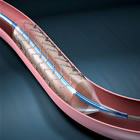 I wrote about this issue over a month ago (see “To Stent or Not to Stent: That is the Question!“) but today’s newspapers are filled once again with the sad story of Maryland cardiologist Dr. Mark Midei, St. Joseph’s Medical Center and the alleged hundreds of unnecessary stents placed in patients who didn’t need them. This sudden renewed interest comes as the Senate investigational report by Senators Baucus and Grassley into this matter was made available — and into the mix of the story was added a pig roast, the Philadelphia mob, Abbott Vascular’s celebration of Midei implanting 30 of their stents in a single day and an email from a company executive, suggesting that someone take a Baltimore Sun reporter outside and “kick his ass!”
I wrote about this issue over a month ago (see “To Stent or Not to Stent: That is the Question!“) but today’s newspapers are filled once again with the sad story of Maryland cardiologist Dr. Mark Midei, St. Joseph’s Medical Center and the alleged hundreds of unnecessary stents placed in patients who didn’t need them. This sudden renewed interest comes as the Senate investigational report by Senators Baucus and Grassley into this matter was made available — and into the mix of the story was added a pig roast, the Philadelphia mob, Abbott Vascular’s celebration of Midei implanting 30 of their stents in a single day and an email from a company executive, suggesting that someone take a Baltimore Sun reporter outside and “kick his ass!”
Hello PR Department.
I’ve got a number of thoughts about all this and will post a more extensive commentary later on, but one major issue in this whole saga is whether or not the stent placements were “unnecessary”, and I ask readers to go back to my October post. Doctors can disagree on whether a stent is called for — especially when they are being guided by the angiogram (X-ray image). And in Midei’s case, two sets of well-known and highly-respected cardiologists have disagreed in most of the disputed cases.
But a technology exists that would have added a whole data set to these cases: it’s called Fractional Flow Reserve (FFR) and it yields a number that can be used as a decision-point about whether to stent or not. The technology is backed up by two-year results from a major study (FAME) that showed improved outcomes with less stents when decision-making was guided by FFR instead of angiography alone — and the use of FFR has been bolstered by an increased level of evidence from the recent AHA/ACC/SCAI Guidelines Update.
So why is it used in only 15% of cath labs?
More later….



